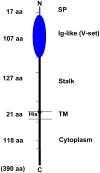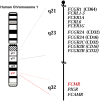The long elusive IgM Fc receptor, FcμR
- PMID: 24793544
- PMCID: PMC4160156
- DOI: 10.1007/s10875-014-0022-7
The long elusive IgM Fc receptor, FcμR
Abstract
IgM exists as both a monomer on the surface of B cells and a pentamer secreted by plasma cells. Both pre-immune "natural" and antigen-induced "immune" IgM antibodies are important for protective immunity and for immune regulation of autoimmune processes by recognizing pathogens and self-antigens. Effector proteins interacting with the Fc portion of IgM, such as complement and complement receptors, have thus far been proposed but fail to fully account for the IgM-mediated protection and regulation. A major reason for this deficit in our understanding of IgM function seems to be lack of data on a long elusive Fc receptor for IgM (FcμR). We have recently identified a bona fide FcμR in both humans and mice. In this article we briefly review what we have learned so far about FcμR.
Conflict of interest statement
Figures










Similar articles
-
The old but new IgM Fc receptor (FcμR).Curr Top Microbiol Immunol. 2014;382:3-28. doi: 10.1007/978-3-319-07911-0_1. Curr Top Microbiol Immunol. 2014. PMID: 25116093 Review.
-
Role of the IgM Fc Receptor in Immunity and Tolerance.Front Immunol. 2019 Mar 22;10:529. doi: 10.3389/fimmu.2019.00529. eCollection 2019. Front Immunol. 2019. PMID: 30967868 Free PMC article. Review.
-
Identity of the elusive IgM Fc receptor (FcmuR) in humans.J Exp Med. 2009 Nov 23;206(12):2779-93. doi: 10.1084/jem.20091107. Epub 2009 Oct 26. J Exp Med. 2009. PMID: 19858324 Free PMC article.
-
Critical role of the IgM Fc receptor in IgM homeostasis, B-cell survival, and humoral immune responses.Proc Natl Acad Sci U S A. 2012 Oct 2;109(40):E2699-706. doi: 10.1073/pnas.1210706109. Epub 2012 Sep 17. Proc Natl Acad Sci U S A. 2012. PMID: 22988094 Free PMC article.
-
Functional Roles of the IgM Fc Receptor in the Immune System.Front Immunol. 2019 May 3;10:945. doi: 10.3389/fimmu.2019.00945. eCollection 2019. Front Immunol. 2019. PMID: 31130948 Free PMC article. Review.
Cited by
-
Immunoglobulin M-degrading enzyme of Streptococcus suis (Ide Ssuis ) impairs porcine B cell signaling.Front Immunol. 2023 Feb 16;14:1122808. doi: 10.3389/fimmu.2023.1122808. eCollection 2023. Front Immunol. 2023. PMID: 36875121 Free PMC article.
-
An Unexpected Role for Cell Density Rather than IgM in Cell-Surface Display of the Fc Receptor for IgM on Human Lymphocytes.Immunohorizons. 2022 Jan 18;6(1):47-63. doi: 10.4049/immunohorizons.2100094. Immunohorizons. 2022. PMID: 35042773 Free PMC article.
-
Differences between Human and Mouse IgM Fc Receptor (FcµR).Int J Mol Sci. 2021 Jun 29;22(13):7024. doi: 10.3390/ijms22137024. Int J Mol Sci. 2021. PMID: 34209905 Free PMC article.
-
Neuropathogenesis of Zika Virus Infection : Potential Roles of Antibody-Mediated Pathology.Acta Med Kinki Univ. 2016;41(2):37-52. Acta Med Kinki Univ. 2016. PMID: 28428682 Free PMC article.
-
Antibody Isotypes for Tumor Immunotherapy.Transfus Med Hemother. 2017 Sep;44(5):320-326. doi: 10.1159/000479240. Epub 2017 Sep 7. Transfus Med Hemother. 2017. PMID: 29070977 Free PMC article. Review.
References
-
- Ravetch JV, Kinet JP. Fc receptors. Annu Rev Immunol. 1991;9:457–92. - PubMed
-
- Daëron M. Fc receptor biology. Annu Rev Immunol. 1997;15:203–34. - PubMed
-
- Monteiro RC, Van De Winkel JG. IgA Fc receptors. Annu Rev Immunol. 2003;21:177–204. - PubMed
-
- Nimmerjahn F, Bruhns P, Horiuchi K, Ravetch JV. FcγRIV: a novel FcR with distinct IgG subclass specificity. Immunity. 2005 Jul;23(1):41–51. - PubMed
Publication types
MeSH terms
Substances
Grants and funding
LinkOut - more resources
Full Text Sources
Other Literature Sources

